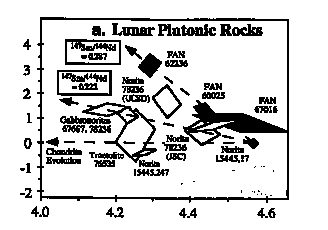EVIDENCE FOR A LREE-DEPLETED SOURCE FOR SOME FERROAN ANORTHOSITES.
Borg, L.E.1, Norman, M.D.2, Nyquist, L.E.1, Bogard, D.1, Snyder, G.3, Taylor, L.3, and Shih, C.-Y.4
1. SN2/NASA Johnson Space Center, Houston,
2. GEMOC, Macquarie,
3. Dept. Of Geol. Univ. Tenn. Knoxville,
4. Code C23, Lockheed Martin, 2400 NASA Road 1, Houston TX 77258.
Introduction: In the lunar magma ocean model ferroan anorthosites (FANs) are expected to be derived from a relatively undifferentiated source with chondritic REE abundances and yield the oldest radiometric ages of any lunar rocks. Sm-Nd isotopic analyses of 60025 and 67016 [1, 2] have yielded ages of 4.44+0.02 Ga and 4.53+0.12 Ga and initial eNd143 values in excess of +0.5. These ages are within error of ages determined on some Mg-suite rocks by [3]. Thus, the existing data do not provide strong verification of the magma ocean model. We have completed isotopic analysis on the pristine FAN 62236 in order to place further constraints on lunar crust forming processes.
Results: The results of our Sm-Nd analyses are presented in Fig.
1. Mineral and chemical separation procedures are described in [4].
The isochron yields and age of 4.29+0.06 Ga and an initial eNd143
of +3.1+0.9. This age is significantly younger than the ages determined
on the other FANs. We have also measured a small positive eNd142 anomaly
of +0.24+0.13 on two separate fractions of 62236.

These results are not predicted by the lunar magma ocean model and may indicate the Sm-Nd systematics of 62236 have been reset by impact metamorphism. However, there is no evidence to support this contention. Sm-Nd abundances in plagioclase mineral fractions are in good agreement with ion microprobe results from other FANs [5] and suggest the isochron is unlikely to represent a mixing line. Thermal resetting of the isochron following impact is also unlikely because this process results in rotation of the isochron about the whole rock point [6] producing an isochron with a younger age and lower initial eNd143. Likewise, extended cooling as a result of insulation by the megaregolith requires the source of 62236 to be even more strongly depleted in LREE to produce the observed high initial eNd143 values prior to 4.29 Ga.
Discussion: Several aspects of these data
are not consistent with a standard magma ocean model. First, the magma
ocean must exist for at least 150 Ma (assuming 60025 is the first FAN)
to 240 Ma (assuming 67016 is the first FAN). Such slow crystallization
rates are at, or beyond, the limits expected from models of thermal evolution
of the magma ocean [7]. Second, the young age of 62236 post-dates formation
of ur-KREEP [8], which is thought to represent the last dregs of magma
ocean crystallization. And, third, high initial eNd143 values and positive
eNd142 require 62236 to be derived from a source that was depleted in LREE
relative to HREE early in its history (Fig. 2). A two-stage
model for the evolution of Nd isotopic composition of 62236 is consistent
with source formation at ~4.46 Ga with a 147Sm/144Nd ratio of 0.29. In
order to reconcile these observations with the magma ocean model 1) the
magma ocean must have existed for a very short period of time, and 2) the
youngest FANs cannot be cumulates of the magma ocean, but must form by
another process.

Figure 2. Crystallization age vs. initial eNd143 for lunar plutonic rocks.
References: [1] Carlson & Lugmair 1988
EPSL 52, 227 [2] Alibert et al., 1994 GCA 58, 2921 [3] Shih et al., 1993
GCA 57, 915 [4] Borg et al, 1996 Meteoritics 32, A18 [5] Phinney, 1991
Proc. 21 LPSC, 29 [6] Nyquist et al 1981 LPSC XXII 985 [7] Tonks &
Melosh, 1990 Origin of the Earth, 151 [8] Nyquist et al., 1992 GCA 56,
2213.

 GEMOC ARC National Key Centre
GEMOC ARC National Key Centre